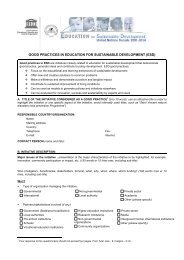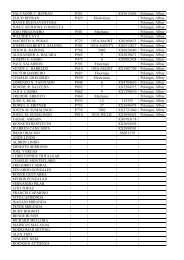Albay CLIM
Albay CLIM
Albay CLIM
Create successful ePaper yourself
Turn your PDF publications into a flip-book with our unique Google optimized e-Paper software.
Sim<strong>CLIM</strong> Modelling System<br />
for the Philippines<br />
27 May 2010<br />
UNDP Conference Room, Makati City, Philippines<br />
NONG C. RANGASA<br />
CIRCA Executive Director<br />
Project Manager, JP UN MDG-F1656 ALBAY DEMO<br />
Partners: Asia Pacific Network (APN)<br />
University of Sunshine Coast, Queensland, Australia/<strong>CLIM</strong> Limited<br />
University of the Philippines Los Banos
History and Overview<br />
• <strong>CLIM</strong>system in collaboration with the<br />
Provincial Government of <strong>Albay</strong>- Centre for<br />
Initiatives and Research on Climate<br />
Adaptation (CIRCA), UPLB and University of<br />
Sunshine Coast, Queensland, Australia has<br />
initiated the first application of the world<br />
leading Sim<strong>CLIM</strong> technology in the<br />
Philippines
Who is Sim<strong>CLIM</strong><br />
• Sim<strong>CLIM</strong> is a computer model system for<br />
examining the effects of climate variability and<br />
change over time and space;<br />
• Sim<strong>CLIM</strong> is an “open framework” modelling<br />
system which allows users to customise the<br />
model for their own geographical area and<br />
spatial resolution and to attach models; and<br />
• It has the capacity to assess baseline climates<br />
and current variability and extremes.
Sim<strong>CLIM</strong> can also be used<br />
• Assess present and future risks<br />
• Investigate present and future adaptation<br />
• Create scenarios of climate and sea level<br />
change<br />
• Conduct sensitivity analyses<br />
• Project sectoral impacts of climate and sea<br />
level change<br />
• Examine risks and uncertainties; and<br />
• Facilitate integrated impacts analyses.
Sim<strong>CLIM</strong> is designed for bridging the gap<br />
between science and policy/planning, particularly<br />
to support decision making and climate proofing<br />
in a wide range of situations where climate and<br />
climate change pose risk and uncertainty; and<br />
Sim<strong>CLIM</strong> and its functionality could be applied in<br />
the work programmes of several agencies in the<br />
country.
Variables that can be included in this<br />
customised Sim<strong>CLIM</strong><br />
• Temperature<br />
• Precipitation<br />
• Solar radiation<br />
• Relative Humidity<br />
• Wind Speed<br />
• Sea surface temperatures<br />
• Sea level Rise
Methods for development of a<br />
Sim<strong>CLIM</strong> for the Philippines:<br />
• Statistical downscaled GCM precipitation<br />
and Temperature change pattern;<br />
• The New GEV analysis method<br />
• Climate variables other than precipitation<br />
and temperature<br />
• Sea surface temperature patterns<br />
• Study Areas<br />
• Applications
Other Considerations:<br />
• The standard <strong>CLIM</strong>systems impact models<br />
will be included with the Philippines <strong>CLIM</strong><br />
package:<br />
• Data Browser<br />
• Extreme Event Analysis<br />
• Sea Level Rise Scenario Generator<br />
• Map Calculator<br />
• Degree day Model; and<br />
• Coastal erosion model
Other Considerations:<br />
• Additional capacity to interface with the<br />
Decision Support System for Agrotechnology<br />
Transfer (DSSAT) and Danish Hydrological<br />
Institute (DHI) Water and Environment MIKE<br />
Series software products can also be<br />
provided as an integral part of Philippines<br />
<strong>CLIM</strong>
DIOS MABALOS<br />
Sim<strong>CLIM</strong> / <strong>Albay</strong><strong>CLIM</strong>







